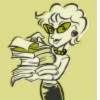 Smith, Cynthia Leitich. Cornelius Van Wright and Ying-Hwa Hu (Ill.) 2000. JINGLE DANCER. New York : Morrow Junior Books. ISBN 978-0-688-162429
Smith, Cynthia Leitich. Cornelius Van Wright and Ying-Hwa Hu (Ill.) 2000. JINGLE DANCER. New York : Morrow Junior Books. ISBN 978-0-688-162429PLOT SUMMARY
“Tink, tink, tink, tink,” sang Grandma Wolfe’s dress. Jenna wanted to jingle dance too, but her dress didn’t have any jingles. Jenna visits family and friends trying to collect just enough jingles for her own dress without compromising the voice of the dresses from which she borrowed. JINGLE DANCER is a story of a young Ojibway girl who wishes to dance her first Jingle Dance at a powwow. Though her grandmother agrees she may dance, it will be up to Jenna to give her dress a voice.
CRITICAL ANALYSIS (INCLUDING CULTURAL MARKERS)
JINGLE DANCER offers an authentic reflection of an intertribal community consisting of Muscogee and Ojibway members. The characters, their relationships, and the book’s illustrations are woven together to paint a picture of a contemporary, close-knit neighborhood preparing for a powwow.
Cynthia Smith takes care to create an extended circle in the main character, Jenna’s, life. Jenna lives with Grandma Wolfe in a contemporary home on a tree-lined street. Throughout the course of Jenna’s quest, she visits three different people, each within walking distance. First, she visits her great-aunt to hear a Muscogee/Creek story. Next, Jenna visits a friend whom she helps make fry bread. Finally, Jenna visits her cousin, Elizabeth, whom she helps carry files. Through the recurring use of the phrase “once again,” Smith clearly defines the ongoing close relationships among them.
Though the great-aunt appears to be retired and Jenna’s friend sells fry bread and Indian tacos, their occupations are not explicitly stated. However, the cousin’s career is made clear. Elizabeth “arrives home late from the law firm” and is carrying a brief case and a newspaper titled Law Review under her arm. This overt illustration of Elizabeth’s profession seems a bit overdone. This may be an attempt by the author to counter negative stereotypes.
Through their illustrations, Van Wright and Hu avoid the “monolithic culture” stereotype by giving each character her own distinct look. The women’s faces are unmistakably different. There is also variation in hair color and texture, and, to a lesser degree, skin tone.
Cynthia Smith, herself a member of the Muscogee Nation, supplies an extensive Author’s Note which includes explanations of Muscogee and Ojibway traditions. This note provides background information on traditional stories, jingle dances, and regalia. A glossary is also provided for some terms which might be unfamiliar. Overall, JINGLE DANCER proves to be an authentic and contemporary story of a young girl looking forward to her first jingle dance.
REVIEW EXCERPTS
“[Jenna’s] promise to dance for the women who cannot dance for themselves illustrate the importance of family and community ties.” (Booklist)
“Seeing Jenna as both a modern girl in the suburban homes of her intertribal community and as one of many traditionally costumed participants at the powwow will give some readers a new view of a contemporary Native American way of life.” (School Library Journal)
Reviews obtained from Follett Library Resources and accessed at:
http://www.flr.follett.com/search?SID=c211074453f514ff63ced2a0fe154f24
CONNECTIONS
Other books about the Ojibway/Chippewa:
King, Sandra, and Catherine Whipple. 1993. Shannon: an Ojibway dancer. Minneapolis: Lerner Publications. ISBN 978-0-822596431
Mercredi, Morningstar, and Darren McNally. 1997. Fort Chipewyan homecoming: a journey to native Canada. Minneapolis: Lerner Publications. ISBN 978-0-8225-2659-9
McCain, Becky R., and Stacey Schuett. 1998. Grandmother’s Dreamcatcher. Morton Grove, Ill: A. Whitman ISBN 978-0-807530320


